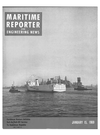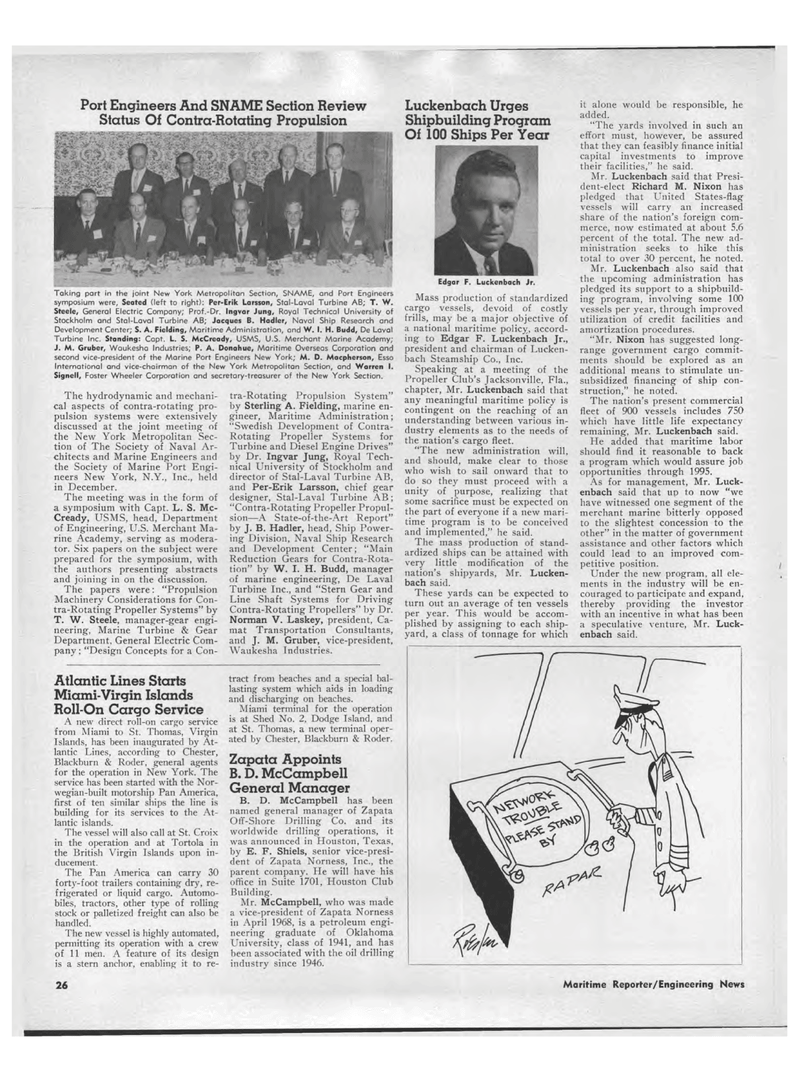
Page 24: of Maritime Reporter Magazine (January 15, 1969)
Read this page in Pdf, Flash or Html5 edition of January 15, 1969 Maritime Reporter Magazine
Port Engineers And SNAME Section Review Status Of Contra-Rotating Propulsion Mm zrjk- |g§r tmpfepi< Luckenbach Urges Shipbuilding Program Of 100 Ships Per Year The hydrodynamic and mechani-cal aspects of contra-rotating pro-pulsion systems were extensively discussed at the joint meeting of the New York Metropolitan Sec-tion of The Society of Naval Ar-chitects and Marine Engineers and the Society of Marine Port Engi-neers New York, N.Y., Inc., held in December. The meeting was in the form of a symposium with Capt. L. S. Mc-Cready, USMS, head, Department of Engineering, U.S. Merchant Ma-rine Academy, serving as modera-tor. Six papers on the subject were prepared for the symposium, with the authors presenting abstracts and joining in on the discussion. The papers were: "Propulsion Machinery Considerations for Con-tra-Rotating Propeller Systems" by T. W. Steele, manager-gear engi-neering, Marine Turbine & Gear Department. General Electric Com-pany ; "Design Concepts for a Con-Atlantic Lines Starts Miami-Virgin Islands Roll-On Cargo Service A new direct roll-on cargo service from Miami to St. Thomas, Virgin Islands, has been inaugurated by At-lantic Lines, according to Chester, Blackburn & Roder, general agents for the operation in New York. The service has been started with the Nor-wegian-built motorship Pan America, first of ten similar ships the line is building for its services to the At-lantic islands. The vessel will also call at St. Croix in the operation and at Tortola in the British Virgin Islands upon in-ducement. The Pan America can carry 30 forty-foot trailers containing dry, re-frigerated or liquid cargo. Automo-biles, tractors, other type of rolling stock or palletized freight can also be handled. The new vessel is highly automated, permitting its operation with a crew of 11 men. A feature of its design is a stern anchor, enabling it to re-Taking part in the joint New York Metropolitan Section, SNAME, and Port Engineers symposium were, Seated (left to right): Per-Erik Larsson, Stal-Laval Turbine AB; T. W. Steele, General Electric Company; Prof.-Dr. Ingvar Jung, Royal Technical University of Stockholm and Stal-Laval Turbine AB; Jacques B. Hadler, Naval Ship Research and Development Center; S. A. Fielding, Maritime Administration, and W. I. H. Budd, De Laval Turbine Inc. Standing: Capt. L. S. McCready, USMS, U.S. Merchant Marine Academy; J. M. Gruber, Waukesha Industries; P. A. Donahue, Maritime Overseas Corporation and second vice-president of the Marine Port Engineers New York; M. D. Macpherson, Esso International and vice-chairman of the New York Metropolitan Section, and Warren I. Signed, Foster Wheeler Corporation and secretary-treasurer of the New York Section. tra-Rotating Propulsion System" by Sterling A. Fielding, marine en-gineer, Maritime Administration; "Swedish Development of Contra-Rotating Propeller Systems for Turbine and Diesel Engine Drives" by Dr. Ingvar Jung, Royal Tech-nical University of Stockholm and director of Stal-Laval Turbine AB, and Per-Erik Larsson, chief gear designer, Stal-Laval Turbine AB; "Contra-Rotating Propeller Propul-sion?A State-of-the-Art Report" by J. B. Hadler, head, Ship Power-ing Division, Naval Ship Research and Development Center; "Main Reduction Gears for Contra-Rota-tion" by W. I. H. Budd, manager of marine engineering, De Laval Turbine Inc., and "Stern Gear and Line Shaft Systems for Driving Contra-Rotating Propellers" by Dr. Norman V. Laskey, president, Ca-mat Transportation Consultants, and J. M. Gruber, vice-president, Waukesha Industries. Edgar F. Luckenbach Jr. Mass production of standardized cargo vessels, devoid of costly frills, may be a major objective of a national maritime policy, accord-ing to Edgar F. Luckenbach Jr., president and chairman of Lucken-bach Steamship Co., Inc. Speaking at a meeting of the Propeller Club's Jacksonville, Fla., chapter, Mr. Luckenbach said that any meaningful maritime policy is contingent on the reaching of an understanding between various in-dustry elements as to the needs of the nation's cargo fleet. "The new administration will, and should, make clear to those who wish to sail onward that to do so they must proceed with a unity of purpose, realizing that some sacrifice must be expected on the part of everyone if a new mari-time program is to be conceived and implemented," he said. The mass production of stand-ardized ships can be attained with very little modification of the nation's shipyards, Mr. Lucken-bach said. These yards can be expected to turn out an average of ten vessels per year. This would be accom-plished by assigning to each ship-yard, a class of tonnage for which it alone would be responsible, he added. "The yards involved in such an effort must, however, be assured that they can feasibly finance initial capital investments to improve their facilities," he said. Mr. Luckenbach said that Presi-dent-elect Richard M. Nixon has pledged that United States-flag vessels will carry an increased share of the nation's foreign com-merce, now estimated at about 5.6 percent of the total. The new ad-ministration seeks to hike this total to over 30 percent, he noted. Mr. Luckenbach also said that the upcoming administration has pledged its support to a shipbuild-ing program, involving some 100 vessels per year, through improved utilization of credit facilities and amortization procedures. "Mr. Nixon has suggested long-range government cargo commit-ments should be explored as an additional means to stimulate un-subsidized financing of ship con-struction," he noted. The nation's present commercial fleet of 900 vessels includes 750 which have little life expectancy remaining, Mr. Luckenbach said. He added that maritime labor should find it reasonable to back a program which would assure job opportunities through 1995. As for management, Mr. Luck-enbach said that up to now "we have witnessed one segment of the merchant marine bitterly opposed to the slightest concession to the other" in the matter of government assistance and other factors which could lead to an improved com-petitive position. Under the new program, all ele-ments in the industry will be en-couraged to participate and expand, thereby providing the investor with an incentive in what has been a speculative venture, Mr. Luck-enbach said. tract from beaches and a special bal-lasting system which aids in loading and discharging on beaches. Miami terminal for the operation is at Shed No. 2, Dodge Island, and at St. Thomas, a new terminal oper-ated by Chester, Blackburn & Roder. Zapata Appoints B. D. McCampbell General Manager B. D. McCampbell has been named general manager of Zapata Off-Shore Drilling Co. and its worldwide drilling operations, it was announced in Houston, Texas, by E. F. Shiels, senior vice-presi-dent of Zapata Norness, Inc., the parent company. He will have his office in Suite 1701, Houston Club Building. Mr. McCampbell, who was made a vice-president of Zapata Norness in April 1968, is a petroleum engi-neering graduate of Oklahoma University, class of 1941, and has been associated with the oil drilling industry since 1946. 26 Maritime Reporter/Engineering News

 23
23

 25
25
